Gene Therapy
Development Overview

On This Page |
How We Help | Where We Help | More on Gene Therapy | Resources |
Maximize Efficiency and Accuracy Across your Gene Therapy Development and Manufacturing Workflow
From the viral vector characterization assays that fuel discovery to potency measurement and safety assays for QC release, our gene therapy manufacturing products bring accuracy and consistency to your results.
How We Help Viral Vector Manufacturing
Drug development and manufacturing has always been a challenging process. When the drug you are developing is a new type of treatment modality, such as a gene therapy, the challenges only increase in complexity.
At Bio-Rad, our goal is to simplify your day-to-day operations and bring clarity to your decision-making by removing complexity from your gene therapy manufacturing workflows. Through products that combine high-performance with ease-of-use and a long track record of success, we make it easy to obtain absolute quantification of viral titer, check for impurities like host cell DNA and mycoplasma contamination and evaluate viral potency for developing and deploying QC release assays. To support you in viral vector manufacturing, whether it is an adeno-associated virus (AAV), adenovirus (Ad), herpes simplex virus (HSV), or something else, Bio-Rad has proven products and a responsive and knowledgeable support team to accelerate your advanced therapeutic development.
Adeno-Associated Virus (AAV) Gene Therapy Applications and Solutions Guide
Explore our suite of customizable products and services, ensuring efficiency, reproducibility, and reliability at every step of your therapeutic discovery, development, and manufacturing process.
Download the Brochure
Did you know?
Results from Phase 3 clinical trials show that one-time, pre-symptomatic administration of the gene therapy Zolgensma continued to show real-world efficacy even five years post-treatment.1 In the absence of treatment, children with SMA-1 would have a life expectancy of less than two years.2
Where We Help Drive Efficiency in Viral Vector Manufacturing
-
Viral Titer Determination
Get the speed and certainty of absolute viral titer determination using Droplet Digital™ PCR (ddPCR™).
-
Viral Vector Characterization
Develop and deploy robust virus potency assays for development and QC release.
-
Viral Vector QC
Find ready-to-use assays to detect harmful contaminants such as pathogenic microbes and host cell debris.
Industry Snapshot: Globally Approved In Vivo Gene Therapies
While gene therapies in clinical trials took a pause in the late 1990s to better understand the immunogenicity and characteristics of different viral vectors,3 the past few years has seen a resurgence of interest in this promising approach. Teams around the world have developed safer and more effective vectors and, while much of the research has investigated AAV production and manufacturing, approved treatments include a range of viral vectors (Table 1).
Our specialists closely follow the latest developments in the field and are excited to support your efforts in expanding the list of approved gene therapy treatments.
Table 1. Globally Approved Gene Therapies.
| Name/Trade Name (Manufacturer) |
Viral Vector Type | Approved Indications | Approval Year and Organization |
|---|---|---|---|
| Cancer | |||
| Talimogene laherparepvec/IMLYGIC® (Amgen) | HSV1 | Local recurrent unresectable cutaneous, subcutaneous, and nodal melanoma after initial surgery | 2015 (USFDA), 2015 (EMA) |
| Mx‐dnG1/Rexin‐G® (Epeius Biotechnolgies) | Retrovirus | Soft tissue sarcoma, osteosarcoma, and pancreatic cancer | 2007 (BFAD) |
| H101/Oncorine® (Shanghai Sunway Biotech) | Ad5 | Nasopharyngeal cancer | 2005 (NMPA) |
| Ad‐p53/Gendicine® (Shenzhen SiBiono GeneTech) | Ad5 | Head and neck cancer | 2003 (NMPA) |
| Ophthalmological diseases | |||
| Voretigene neparvovec/LUXTURNA® (Spark Therapeutics) | AAV2 | Leber's congenital amaurosis (Biallelic RPE65 mutation‐associated retinal dystrophy) | 2017 (USFDA), 2020 (Health Canada), 2020 (TGA) |
| Neurological diseases | |||
| Onasemnogene abeparvovec/ZOLGENSMA® (AveXis, now Novartis Gene Therapies) | AAV9 | Spinal muscular atrophy (SMA) with bi‐allelic mutations in the survival motor neuron 1 (SMN1) gene in pediatric patients less than two years of age | 2019 (USFDA), 2020 (EMA), 2020 (JMHW) |
| Metabolic diseases | |||
| Alipogene tiparvovec/Glybera® (UniQure) | AAV1 | Lipoprotein lipase deficiency | 2012 (EMA) |
*Excerpted from Zhao, et al.,2 Table 1 (available via CC-By-4.0).
More on Gene Therapy Development and Manufacturing
Articles
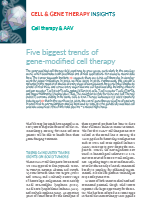
5 Biggest Trends of AAV-Based Gene Therapies
Hear from industry thought leaders in cell and gene therapy on five key trends for AAV gene therapies and issues in the field today.

Harnessing Analytical Technologies to Modify Your AAV Development Workflow
Discover how the latest analytical tools can achieve different assays with high reproducibility and accuracy.

Regulatory Expectations and Guidelines Around AAV Gene Therapy
Gain insights into regulatory considerations for AAV-based gene therapies from industry thought leaders in cell and gene therapy.
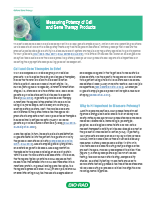
Tips for Meeting Regulatory Guidelines for AAV Development
Find tips on meeting regulatory guidance for gene therapies from industry experts in cell and gene therapy.
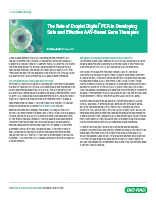
Developing Safe and Effective AAV-Based Gene Therapies Using ddPCR™ Technology
Learn how ddPCR technology offers the accuracy to quantify AAV viral titers to support many aspects of quality control for AAV-based gene therapy development.
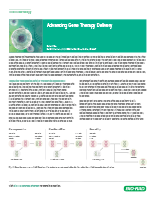
Advancing Gene Therapy Delivery
Discover different delivery systems used for advancing gene therapy, including viral and non-viral vectors, and the benefits and challenges of each approach.

Measuring Potency of Cell and Gene Therapy Products
Explore the common challenges, analytical tools, and importance of selecting appropriate assays for the development of potency assays for cell therapy products.

Understanding Potency in Cell and Gene Therapy Development
Read about the current state of the industry, challenges associated with potency assays, and measuring product potency throughout the manufacturing process.

From Concept to Cure: Using AAV in Gene Therapy
Use this guide to approach various AAV vector challenges, AAV characterization, and address developmental hurdles with using vectors in gene therapy.
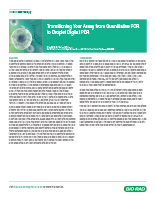
Transitioning Your Assay from Quantitative PCR to Droplet Digital™ PCR (ddPCR™)
Get guidance on how to transition from qPCR to ddPCR technology and the differences to consider between the two methods based on AAV titering assay study.

Measuring AAV Vector Genome Titer Using Droplet Digital™ PCR Protocol
Get started with this protocol designed to measure AAV vector genome titer using ddPCR technology for both in-process and purified samples.

Image Lab Tutorial: How to Quickly Measure Capsid Protein Ratios
Watch this video tutorial on how to assess AAV capsid protein ratios as a fast quality control step in gene therapy development and manufacturing.
Resources
Webinars
-
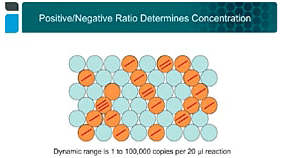
Introduction to Droplet Digital PCR: Workflow and Applications
Learn the concept, workflow, and diverse applications of ddPCR technology showcased in recent journal publications.
-
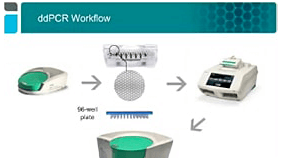
Droplet Digital PCR Tips and Tricks: ddPCR Assay Design
Find tips and tricks used in ddPCR assay design. Topics covered include the availability of commercial ddPCR assays.
Publications
Systemic Treatment of Fabry Disease Using a Novel AAV9 Vector Expressing α-Galactosidase A
Biferi MG, et al. Mol Ther Methods Clin Dev. 2020 Oct 22;20:1-17. doi: 10.1016/j.omtm.2020.10.016
Hair Cell Transduction Efficiency of Single- and Dual-AAV Serotypes in Adult Murine Cochleae
Omichi R, et al. Mol Ther Methods Clin Dev. 2020 May 13;17:1167-1177. doi: 10.1016/j.omtm.2020.05.007
Documents

Adeno Associated Virus: Enabling Genomic Medicine
Learn how Droplet Digital PCR is a viable alternative for rAAV titering with several inherent benefits.

Transitioning Your Assay from Quantitative PCR to Droplet Digital PCR
Learn how transitioning your assay from qPCR to ddPCR technology can be simple and provide consistent results.

ddPCR Assays for Adeno-Associated Virus (AAV) Vector Genome Titer
Discover the complete ddPCR technology workflow solution for absolute quantification of AAV vector genome copies.

ddPCR Viral Quantification: Success Story
Read this success story to learn how ddPCR technology represents a highly precise method for determining AAV vector genome titers.
Webinars
-
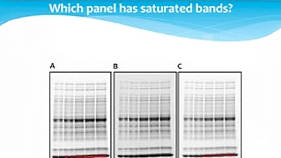
Can We Trust Western Blots?
Learn how to build confidence in western blotting data and tips for producing high-quality western blots in less time.
-
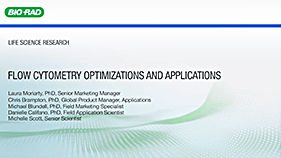
Expert Coffee Chats — Flow Cytometry Optimizations and Applications
Find flow cytometry topics related to gene therapy workflows including considerations for consistency across instruments in multiple labs (46:10) and switching from single tubes to plate-based high-throughput analysis (57:20).
Publications
Two-Dimensional Droplet Digital PCR as a Tool for Titration and Integrity Evaluation of Recombinant Adeno-Associated Viral Vectors
Furuta-Hanawa B, et al. Hum Gene Ther Methods. 2019 Aug 1; 30(4): 127–136. doi: 10.1089/hgtb.2019.031
Using ddPCR to Accurately Quantify AAV Viral Titre and Integrity
The Manufacturing Chemist, 29 July 2021. Accessed July 15, 2022.
Documents

Automation of High-throughput Flow Cytometry with the ZE5 Cell Analyzer
Learn how integrating flow cytometers into automated workcells increases throughput, enables efficient operation, and provides consistent results.
Documents

Understanding Potency in Cell and Gene Therapy Development
Read about the current state of the industry, challenges associated with potency assays, and measuring product potency throughout the manufacturing process.

Measuring Potency of Cell and Gene Therapy Products
Explore the common challenges, analytical tools, and importance of selecting appropriate assays for the development of potency assays for cell therapy products.

Regulatory Expectations and Guidelines Around AAV Gene Therapy
Gain insights into regulatory considerations for AAV-based gene therapies from industry thought leaders in cell and gene therapy.
-

The Role of qPCR and ddPCR™ in Potency Analysis
Learn about the multiple advanced nucleic acid quantification technologies that can support accurate, streamlined potency assays.
Documents
-
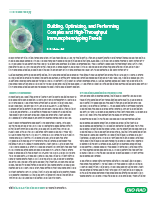
Building and Optimizing Complex, High-Throughput Immunophenotyping Panels
Follow best practice guidelines on aspects of immunophenotyping for building, optimizing, and performing complex and high-throughput immunophenotyping panels.

Elucidating Complex Flow Cytometry Studies with the Speed and Sensitivity of the ZE5 Cell Analyzer
Discover how the ZE5 Cell Analyzer obtains biologically relevant data from increasingly complex studies such as exosome analysis and immunophenotyping in a high-throughput manner.
Publications
Insights on Droplet Digital PCR–Based Cellular Kinetics and Biodistribution Assay Support for CAR-T Cell Therapy
Sugimoto H, et al. AAPS J. 2021 Mar 2;23(2):36. doi: 10.1208/s12248-021-00560-6.
Documents

Regulatory Expectations and Guidelines Around AAV Gene Therapy
Gain insights into regulatory considerations for AAV-based gene therapies from industry thought leaders in cell and gene therapy.
-

Balancing qPCR and ddPCR™ in Therapeutic Development
Gene expression analysis is a critical part of the drug discovery and development process. Here's how RT-qPCR and ddPCR can be used to support various stages across the drug development pipeline, from discovery to manufacture.
Documents
-

Purification of Adeno-Associated Virus Using Ion Exchange and Mixed-Mode Resins
Explore how ion exchange and mixed-mode resins demonstrate the ability to achieve high recovery yields and excellent impurity clearance in an adeno-associated virus (AAV) purification workflow.
Documents

Replication-Competent Virus Testing
Discover an attractive orthogonal method for testing replication-competent viruses to ensure safe treatment, with high sensitivity and fast turnaround time.

Transitioning from Quantitative PCR to Droplet Digital PCR for Mycoplasma Detection
Review strategies for overcoming challenges, developing robust methods, and advancing your viral vector manufacturing processes.

Quality Control Solutions for Cell And Gene Therapy
Discover our comprehensive portfolio of ddPCR solutions for cell and gene therapy applications.

Vericheck ddPCR HEK293 Residual DNA Sizing Kit
Discover the HEK293 specific ddPCR-based sizing solution, capable of measuring HEK293 without the use of reference curves and designed and validated to meet regulatory guidance requirements.
References
- New Zolgensma data demonstrate age-appropriate development when used early, real-world benefit in older children and durability 5+ years post-treatment. Novartis. Accessed July 5, 2022. https://www.novartis.com/news/media-releases/new-zolgensma-data-demonstrate-age-appropriate-development-when-used-early-real-world-benefit-older-children-and-durability-5-years-post-treatment
- Finkel RS, McDermott MP, Kaufmann P, et al. Observational study of spinal muscular atrophy type I and implications for clinical trials. Neurology. 2014;83(9):810-817. doi:10.1212/WNL.0000000000000741
- Zhao Z, Anselmo AC, Mitragotri S. Viral vector‐based gene therapies in the clinic. Bioeng Transl Med. 2021;7(1):e10258. doi:10.1002/btm2.10258
Receive Updates
Keep up to date with useful tips and online resources to continuously improve your viral vector manufacturing workflows.
Sign up to be notified when new resources like publications, protocols, webinars, and how-to videos become available.



